Back in 2015, Tom Wood had explained the work done by Iloura‘s teams on Mad Max: Fury Road. He went on to work on The Last Witch Hunter, Allegiant and A Wrinkle in Time.
How did you get involved on this movie?
Way back in April 2019 I was approached by Warner Brothers who were developing the Untitled Elvis project in New York with Baz Luhrmann. One of the producers attached was Patrick McCormick, an old friend I had previously worked with on Disney’s Prince of Persia. In May 2019 I was flown to NY for meetings with Baz and the deal was done.
How was the collaboration with Director Baz Luhrmann?
Baz Luhrmann is a very much a reflection of his work. He immerses himself in the subject, every tiny narrative detail is learned and processed. He has a group of assistants who constantly feed facts and images. His wife, Catherine Martin, the Production Designer and Costume Designer, also has a small team sourcing the images and footage that cross correlates with Baz’s team. This all comes together in an enormous montage of audio and visuals. Only by reviewing and re-reviewing can this plethora be paired back to the essential. This was also the way for VFX to work for him.
In prep Baz already had his Art Dept concept artist create a number of the major venues in Unreal. While he does not pre-viz, these were fully 3d environments he could move around within. He would pass loose ideas of shots to VFX to “Tech-viz”, to produce real world possibilities. We worked with Director of Photography Mandy Walker and her grip team to define the scope of what the shooting equipment could achieve to pass back to Baz.
During the shoot our main game was to collect and collate everything we could. We cyber-scanned every main character in every costume, we cyber-scanned every extra in every crowd scene(800+ at last count). Our wrangler team surveyed, photogrammetry’d and photo textured every set, in beauty and flat light. Scenes were constantly moving, being re-written and re-conceived. Shooting solutions were required each day to achieve the new briefs. We had augmented reality, virtual extensions, set up in Unreal that were used on the Hollywood Sign, Showroom and Graceland sets. Interactions with Baz during production were few and brief. My involvement was with the shooting crew, how could VFX assist them, how could VFX influence towards a better result.
In post the VFX involvement increased, as expected. Post-viz became a massive part of our process.
I’ve always been a huge fan of knowing where you’re going, your visual destination, before you set out with the big tools. We used in house artists and some of the smaller VFX vendors, notably Cumulus Visual Effects and Fin Design + Effects, to run out temporary composites at Director’s cut stage. Baz was able to critique and change his content and cut without the huge expense of a final shot change. He often thought the post viz shots were being presented as final because of the high quality achieved at this stage.
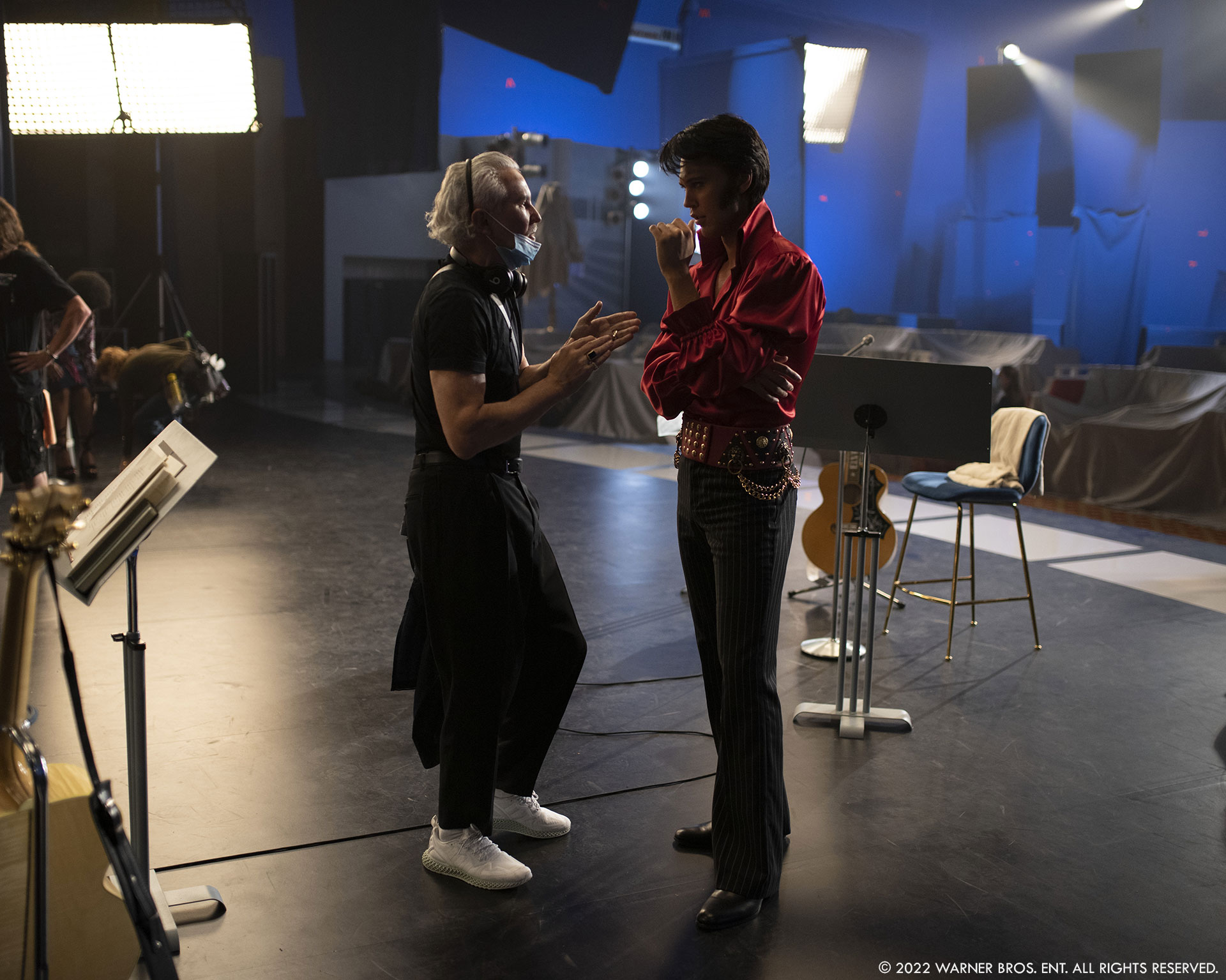
What was your feeling to work with such iconic director?
It was really interesting to see the machine that surrounds and drives him through his process. He is the centre of the hurricane, if you’re not equipped to get in his path you won’t make it – we learned pretty fast! Everything we presented to him had to be tight and justified. The prep we had done, the data we collected, the briefs I took, (no matter how fly away they appeared), all paid off. There’s nothing like being in his sights for the wrong thing and nothing better than being in the warm glow of his approval.
How did you organize the work with your VFX Producer?
I had worked closely with Fiona Crawford on George Miller’s Mad Max: Fury Road so we had a good working relationship. We had permanently open dialogue and kept each other informed of both sides of the jobs. In post this became so much more pertinent as the budget was extremely limited, cheaper but visually compelling solutions had to be designed. We were quite direct with our expectations of process with the vendors to ensure costs didn’t spiral.
How did you choose the various vendors?
As this was an entirely Australian rebate film, we were encouraged to use Australian vendors. This meant we used nearly ALL Aussie vendors, 14 in the final count.
We split the work up into crowd scenes and environments. We had to assign the crowd scenes to vendors that had established crowd pipelines, Rising Sun Pictures (RSP), Method Studios and Mr. X (now MPC). The crowds HAD to reflect the energy of the scenes, so actions had to be precise and specific. We did not do any motion capture, rather allowing the vendors to use their extensive libraries to fill in.
FIN also took on a crowd sequence that was no less complex, the Hayride concert that reveals Elvis’s super-hero performance. This was never budgeted as a crowd extension, being intended as a very dark auditorium. On the day of the shoot, Baz changed it up as it was as much about the crowd reaction as Elvis’s performance. We shot extras from multiple angles against blue for FIN to use a card based crowd system, filling the Shreveport Auditorium.
Almost every vendor had shots that required BG Digital-doubles, but they were limited in scale and numbers. BG extras in environments are an expected element, but we still had to be careful of demands and expectations.
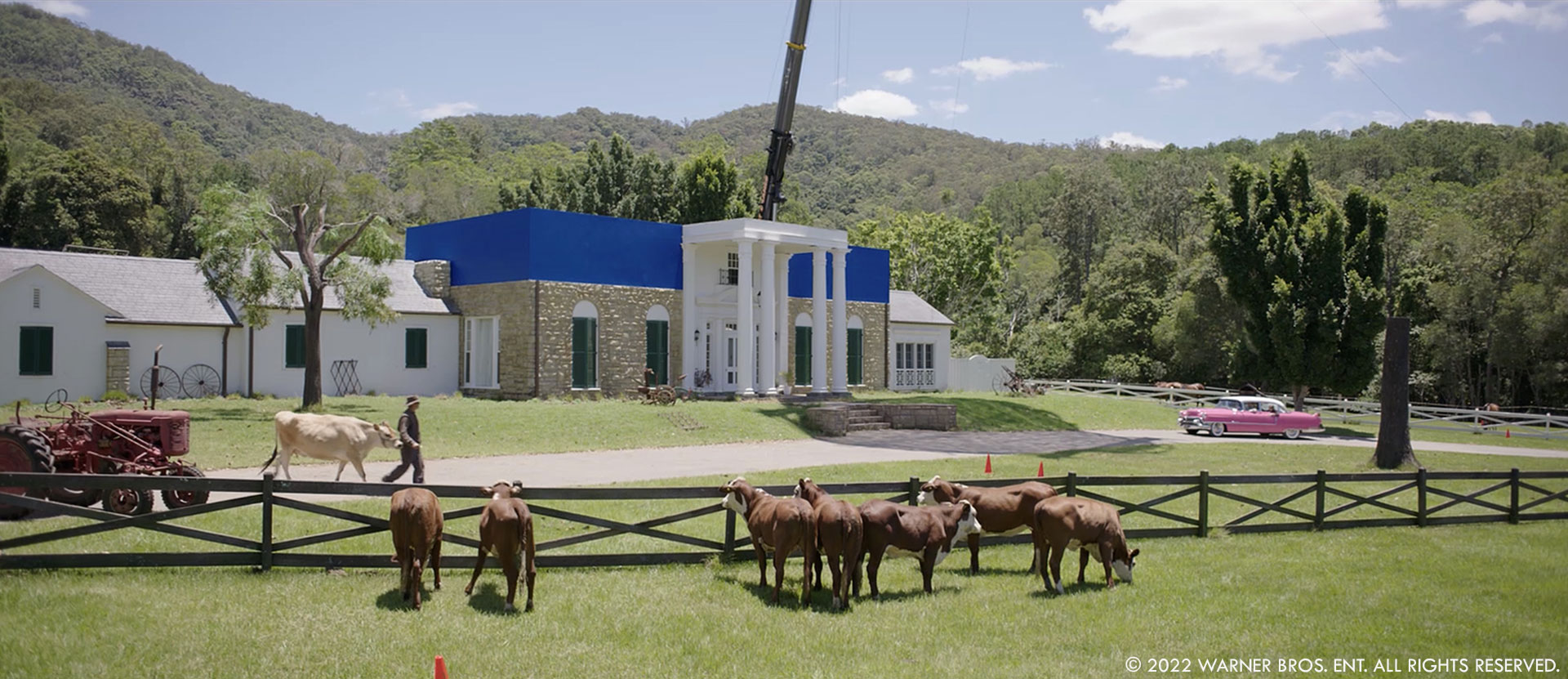
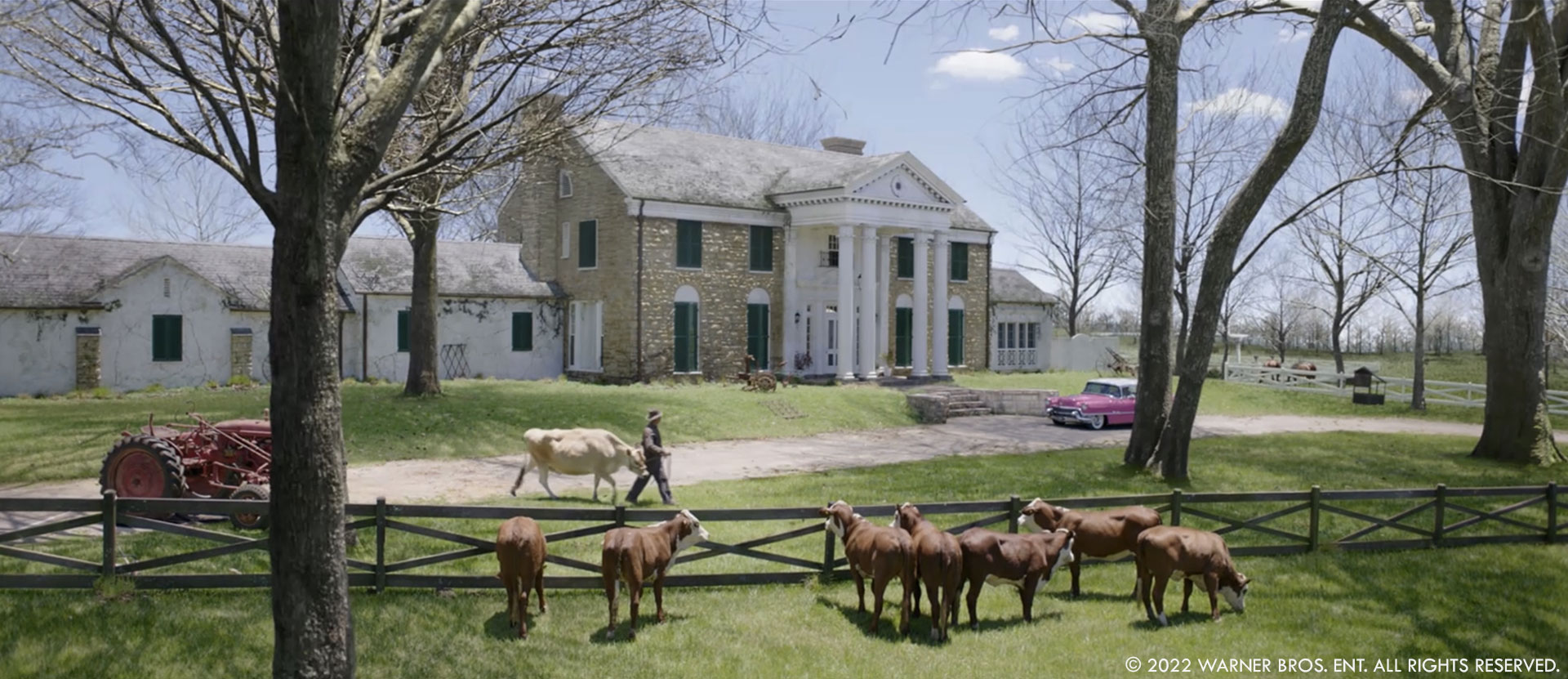
Can you tell us how you split the work amongst the vendors?
As Covid settled into our lives, the prospect of vendors losing crew was a real problem that we and the vendors were very attuned to. We agreed with them all not to over burden them and agreed at top end budget limits. This would ensure a comfortable run of show for them and the production. Method, Mr. X and RSP had crowd pipelines that made them immediately suited to significant scenes. This gave us, when coupled with the outer limits we had agreed to, really obvious divisions making the allocation fairly straight forward. FIN and Cumulus assisted with our postviz so effectively, their sequences were also a very easy choice for us to keep them going to final completion.
How was the collaboration with their VFX Supervisors?
The vendors were fantastic. In post we had regular, weekly Zoom calls. This is the new process both due to the distances in Australia and post pandemic. We never did catch up face to face with any of our vendors, only virtual zoom meetings.
What was your approach to recreate the various locations?
The internet and Art Department provided everything we needed to recreate period Beale Street, Memphis, Graceland (3 periods) and Las Vegas.
The Hollywood sign is a true representation of the old sign, at its low point. Luma Pictures, under the supervision of Brendan Seals used their LA office to organise and deliver photo surveys and photogrammetry of the hillside and high resolution, time accurate panoramas of the LA sprawl. Luma also created Graceland true to 3 periods. The earliest, farm incarnation was the hardest as we could only reference a few black and white photos, including the sale document. The later versions are more manicured. The major issue was the tree growth across the 20 years. Luma filled out the trees gradually, ending up with the 1970’s version matching the real Graceland audiences can visit today.
Future Associate created the MGM backlot to fit our shoot. It is loosely based on the real backlot, sitting on Main Street with the Administration Building in the distance. Creative license had to be taken to adapt the wrong direction stage lighting to the narrow canyons of sound stages. FA added reflected sunlight from angled windows to justify the stage “sun” coming from multiple directions.
Method, supervised by Josh Simmonds, added their own extensive research to the plethora of drawings, plans and photos from the Art Department to top up and extend our original 150m Beale Street, single story, set. With the direct assistance from Damien Drew, the Supervising Art Director, Method created a very true to reality/history environment. There are theatres on the bend showing period movies, real hotels and stores from the period dressed with produce from the time. We see the street in daylight in 1953 and night in 1956. Each time the window dressing and signage is true to the year along with appropriate cars and pedestrians.
Cumulus created the Lauderdale Courts social housing development the Presleys lived in as Elvis first started to be noticed. The buildings still stand today so were relatively straight forward to recreate. However, today they face onto an elevated highway on approach to a Mississippi bridge. Cumulus referenced period photos from the area and various Queensland shacks and brick buildings to develop the required transition to poverty across the street that Baz required narratively.
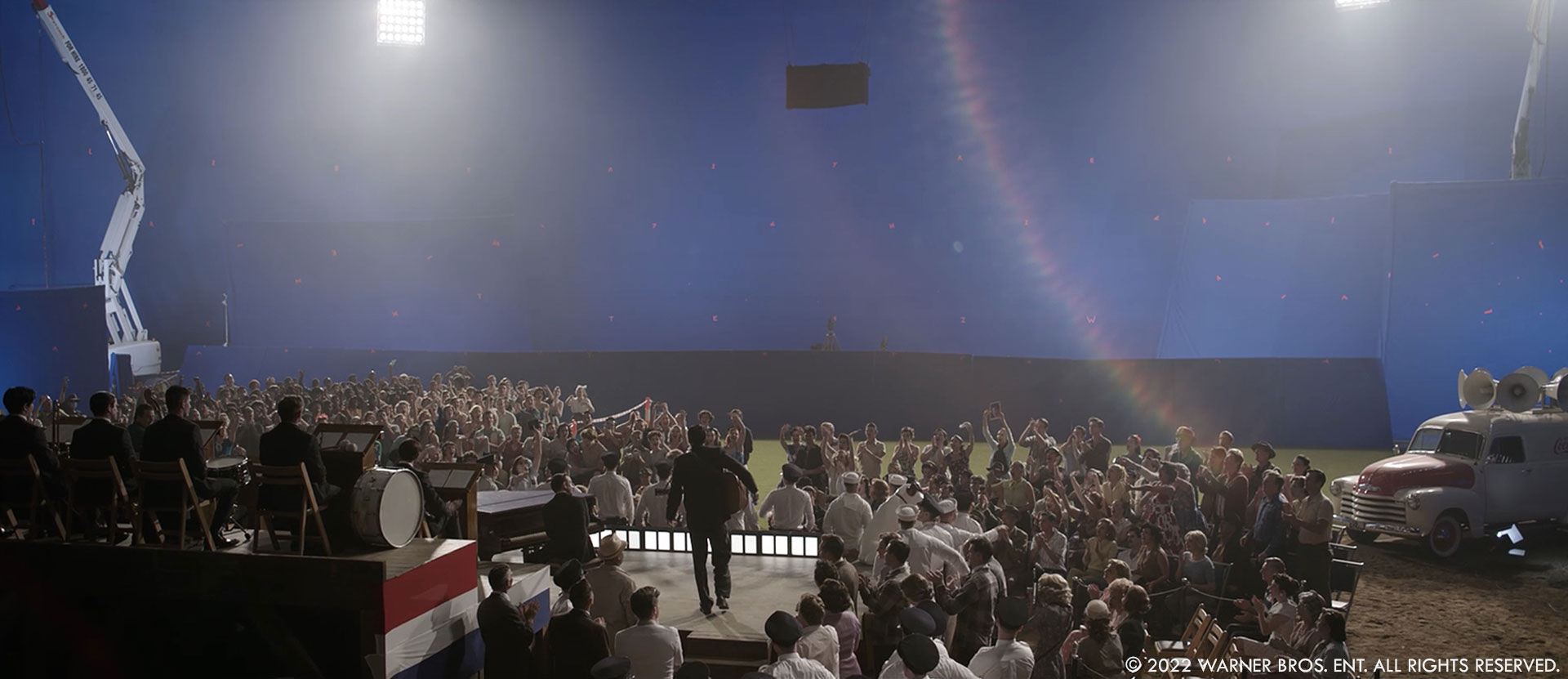
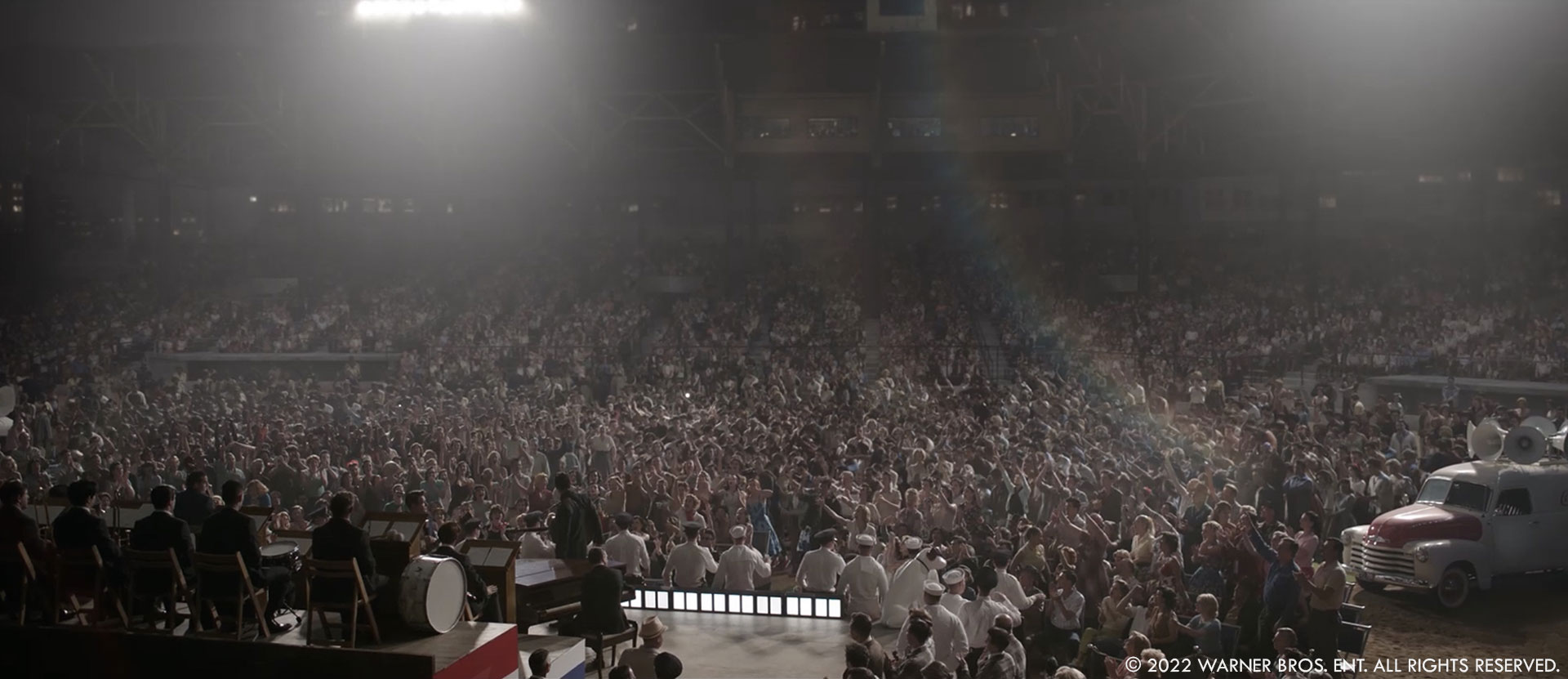
Which location was the most complicate to create and why?
Rising Sun Pictures created the 2 periods we see Las Vegas. The movie opens in 1997 period Vegas, cutting between archive WB aerial footage and RSP created International Hotel environment, as Col Tom Parker is rushed to hospital. The hotel in this period is 3 times the size of its original build, so the huge wings had to be added. The sign is very different from the real sign at this time. It was felt that the sign was the pivotal anchor around which we travel through time, back to 1973. The scale of the real 1997 sign (it is ludicrously vast) made this impossible, so an adapted version of the original sign was updated to 1997 technology to carry us across.
The 1968 Las Vegas that RSP built is largely true to geography. The details are entirely based upon reference movies, footage and photos. We built 9 key Casinos, emphasising their huge, iconic marquee signs. The patterns and sequences of lights animating across each sign is authentic, as is the main casino buildings lining the strip.
Production and the RSP team, under the supervision of Julian Hutchens, referenced footage from the period on 35mm film, examining the light response of the available film stock. RSP adapted that look to apply to the footage, giving us a little more range than the original emulsions. Aerial shots were given a real period feel using movement derived from period movies. Easy Rider’s closing shot was analysed, researching the equipment used to pull back from the crashed bikes. This movement was applied to many aerial shots, including Luma’s big Hollywood Sign pull back. RSP used many of their established city building procedures, populating buildings, roads ,cars and parks out to the surrounding mountains. The views from Elvis’s hotel suite were so authentic looking, the harsh desert sun and multicoloured twinkling bokeh at night blew Baz away.
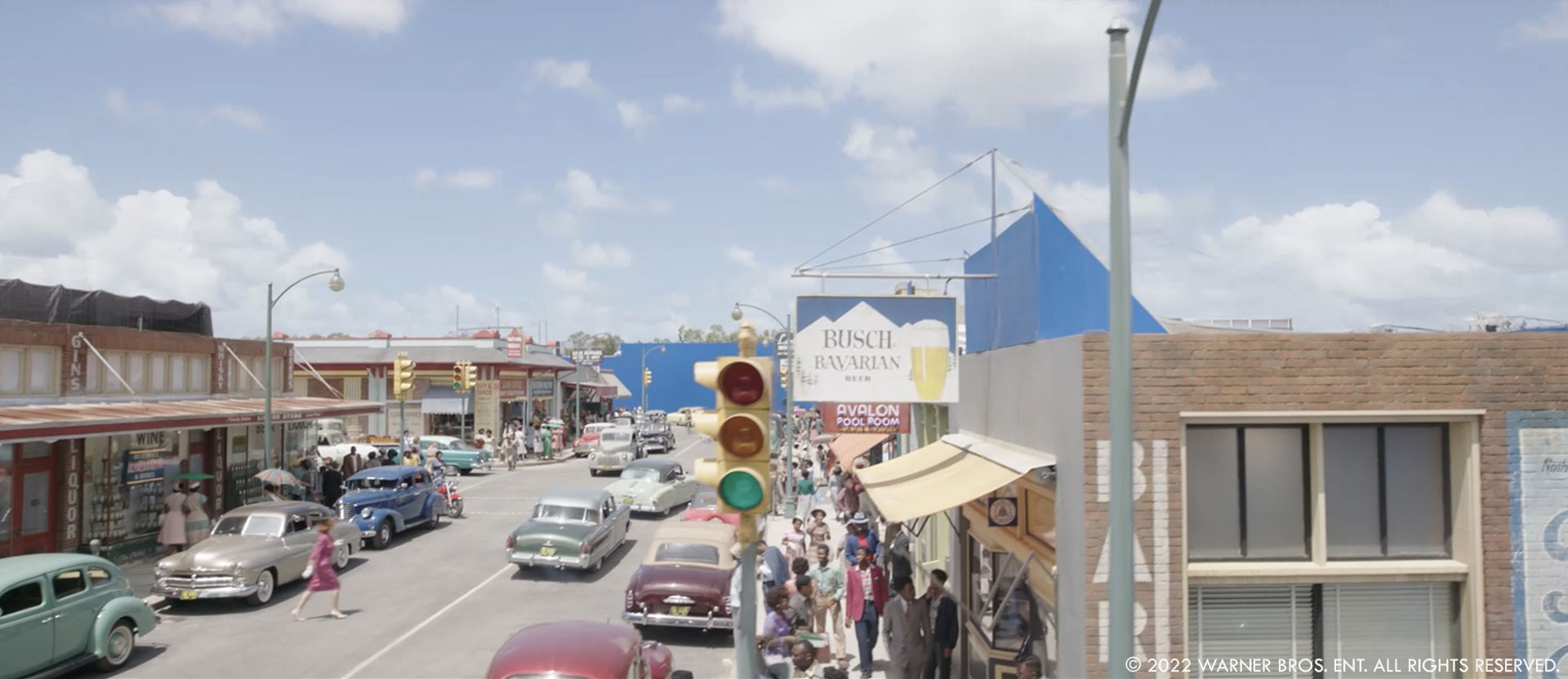
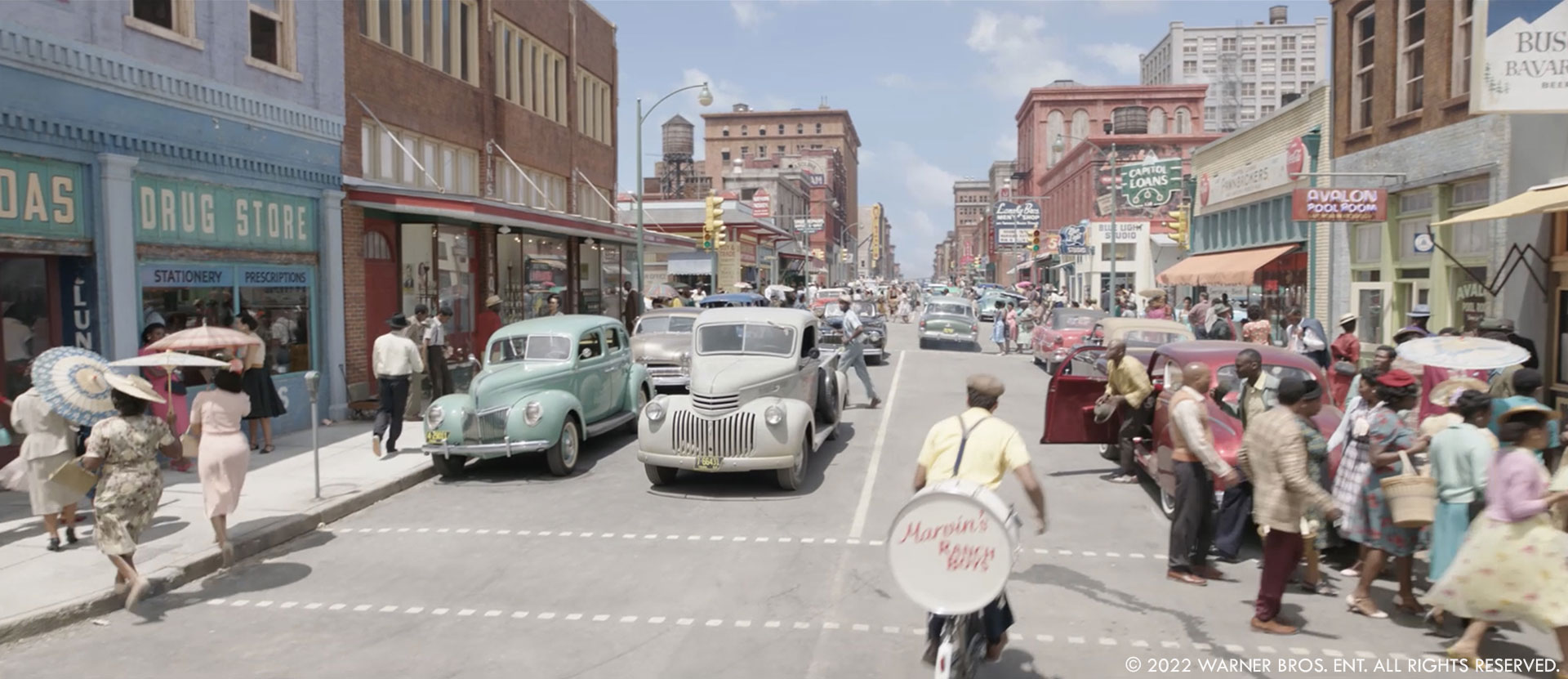
The movie is full great transitions. Can you elaborates about them?
The movie is a series of montages to enable Baz to include as much true information as possible. To join many of these together without losing energy the montages are themselves montaged together.
The editorial department handled the initial content for the most part, with VFX producing the final result. Many were handed to VFX as entering and exiting clips with an instruction to join. These changed almost daily as the cut shifted, so we had to pivot and adjust in as agile a manner as possible to accommodate.
FIN were instrumental in producing many of these including the “Burning Love” split-screen sequence. I had in prep produced a number of video reference collections for Baz, depicting the emergence and use of split screens through the decades after the introduction of the optical printer. Norman Jewison’s “Thomas Crown Affair” was our most referenced clip, Pablo Ferra, the designer, made such an iconic piece of film, integrating music and narrative so effortlessly. We referenced this and many other period sequences to add authentic 1970’s detail to the split screens, bleed, grain and slight sprocket weave.
The makeup work is great in the movie. Did you need to enhance some of them?
The prosthetics are incredible in this movie. Tom Hanks clearly is inside a full face mask throughout but it only takes seconds for the audience to see beyond that and be engrossed in his performance. Austin had 5 or 6 stages of prosthetic augmentation. He always had the chin addition, then his face progressively gets fuller until his final performance. Schedule and time were against the implementation of the make up, 4-6 hours in the chair poor to going on set every day wears thin. But the product is so good we couldn’t help but be involved to ensure they look perfect in every shot. VFX augmented 800 or so shots, the majority being completed by a small team at Double Barrel in Perth. Each major vendor also worked their shots when required.
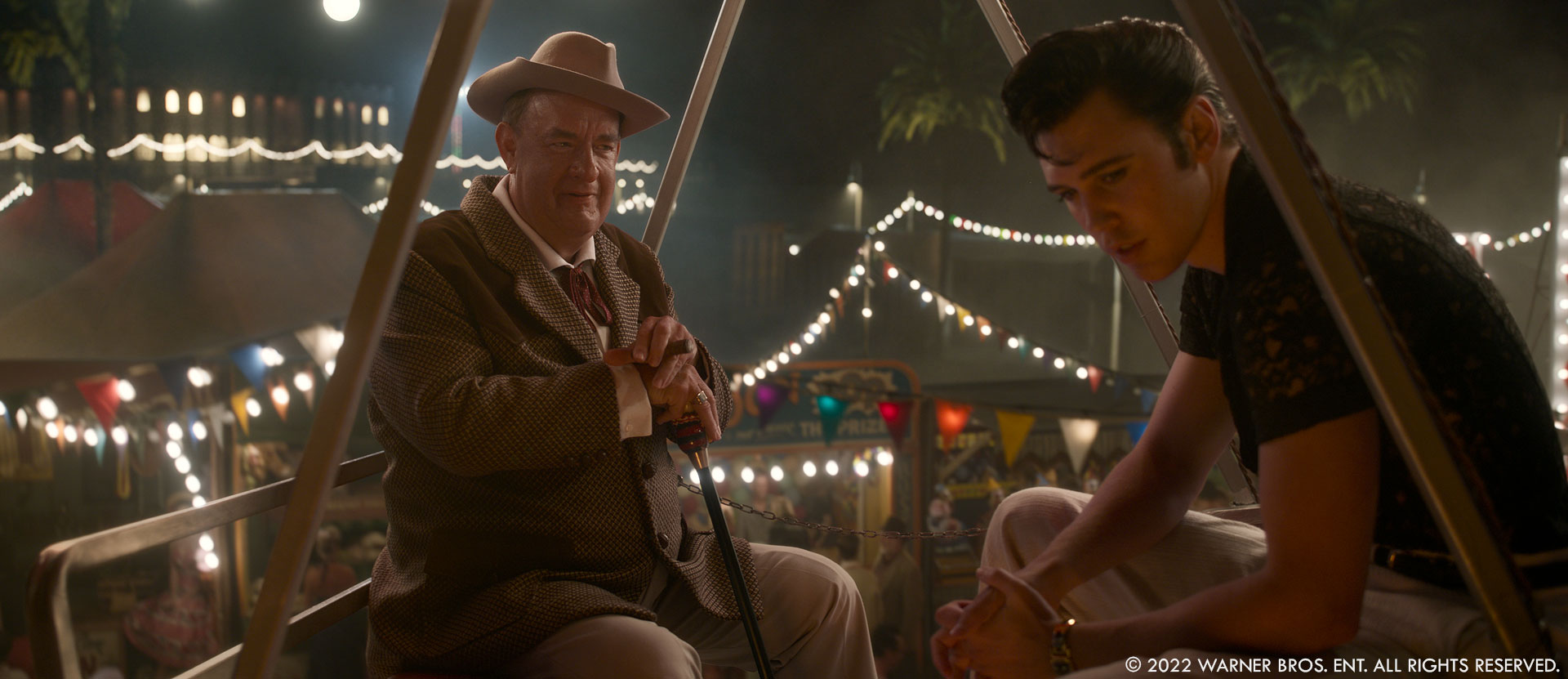
Which sequence or shot was the most challenging?
Right from the very first meeting, we anticipated face replacements of Austin onto Elvis in archive footage. This is always a VFX nightmare, trying to match camera moves, performances, lighting etc. It was definitely the most difficult and demanding effect required from VFX. We tested, on the suggestion of my son, to try a deep fake, AI, approach. Luma, FIN and RSP all tried it out as no one had attempted it previously. RSP’s result, partnering with the Australian Institute of Machine Learning, was a clear winner. The initial tests used the standard “deep fake” resolution of 128 pixels square. For the final film we needed an almost half screen height image at 3.5K. This is an enormous, exponential difference when it comes to machine learning. We shot multiple angles and multiple light condition of Austin against a neutral background. 10 minutes of footage was selected at 24fps, at 4K. This was ingested through the ML process along with our 4K scans from original negative movie shots of Elvis in “Live a Little, Love a Little”. RSP developed processes to overcome the gargantuan memory requirements to process out the results at the required resolution. Then composited the face back onto the Elvis footage, matching grain and grade. The result is technologically spectacular, but sadly, flashes by in a fast paced comedic montage.
Is there something specific that gives you some really short nights?
The pandemic’s arrival meant we had to focus on process and staged delivery. It really pulled everyone together towards a common goal. It also gave us a little more time. This meant that more than any other show I’ve been involved with, we were able to run it smoothly and comfortably. I hope the vendors felt the same, we endeavoured to protect them as much as possible throughout, knowing how fragile they became.
What is your favorite shot or sequence?
The 2 sequences I love most are RSP’s drive into Vegas and Method’s drive into Beale Street. The Vegas sequence is only 3 or 4 shots long now but there are another 4 shots on the cutting room floor that are also spectacular. A half day shoot with a limo surrounded by blue screen with short sequence from “Aria” as a reference for the look. The actors were magnificent, their eyes full of wonder (looking at some moving laser pointer eye lines).
The Beale Street night scene entry is amazing, until the very last moment we had always heard it with Kanye’s “Black Skinhead” playing at 11. The live action was shot with this track during a single night and the atmosphere and energy amongst the crew and cast was electric. The track was changed out unfortunately.
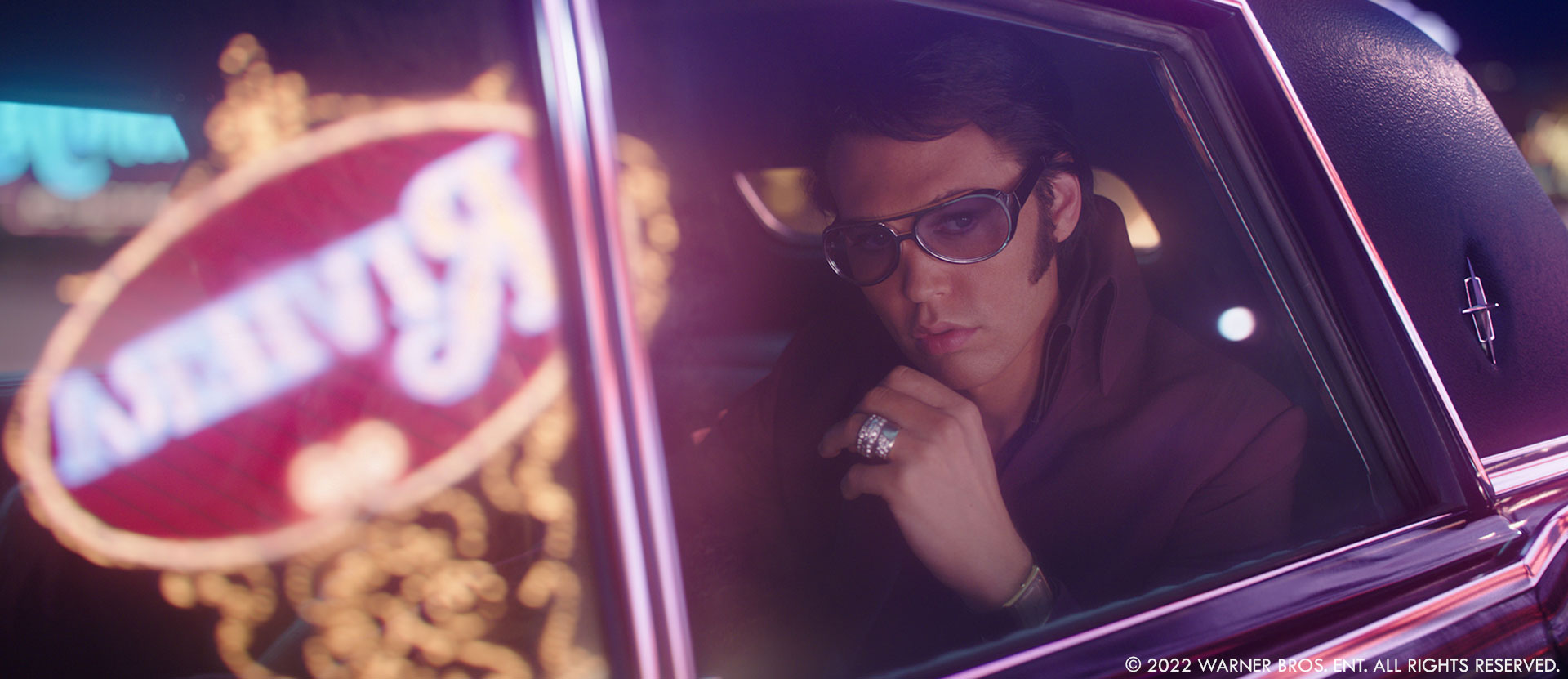
What is your best memory on this show?
The LAX airstrip sequence was the most memorable day’s shoot for me. We arrived on the smallest process stage on the lot expecting to shoot a limo interior only with Elvis’s Gulfstream II stairway behind. The Art department had built the private plane’s steps to fill one side of the car’s view. The morning of the shot Baz revealed he wanted the Lisa Marie, Elvis’s private commercial airliner, not the Gulfstream. A staircase was quickly painted blue while a second limo was brought in play as a “spy exchange” on the desolate far side of the airport. The lighting was adapted to light 2 cars not one, leaving only a flat light look possible in the tiny space. Hoola hoops were bought to stand in for the large jet intakes hovering above the cars. I smashed together a Sketchup model of the cars and the jet and an it through an augmented reality viewer to guide the wider shots and give Baz, the actors and crew an idea of what was going to be there. FIN took on the post work and produced a great, balanced result from really challenging footage. We relied, pushing hard, on the dull, flat light rarely seen in LA, just after the rain, huge cumulus clouds over the San Gabriel Mountains and wet tarmac replacing the black wooden stage floor. The atmosphere we created was so perfect for the scene, reflecting Elvis’s descending enthusiasm with his existence. He has all the trappings of materialism but no longer the ambition.
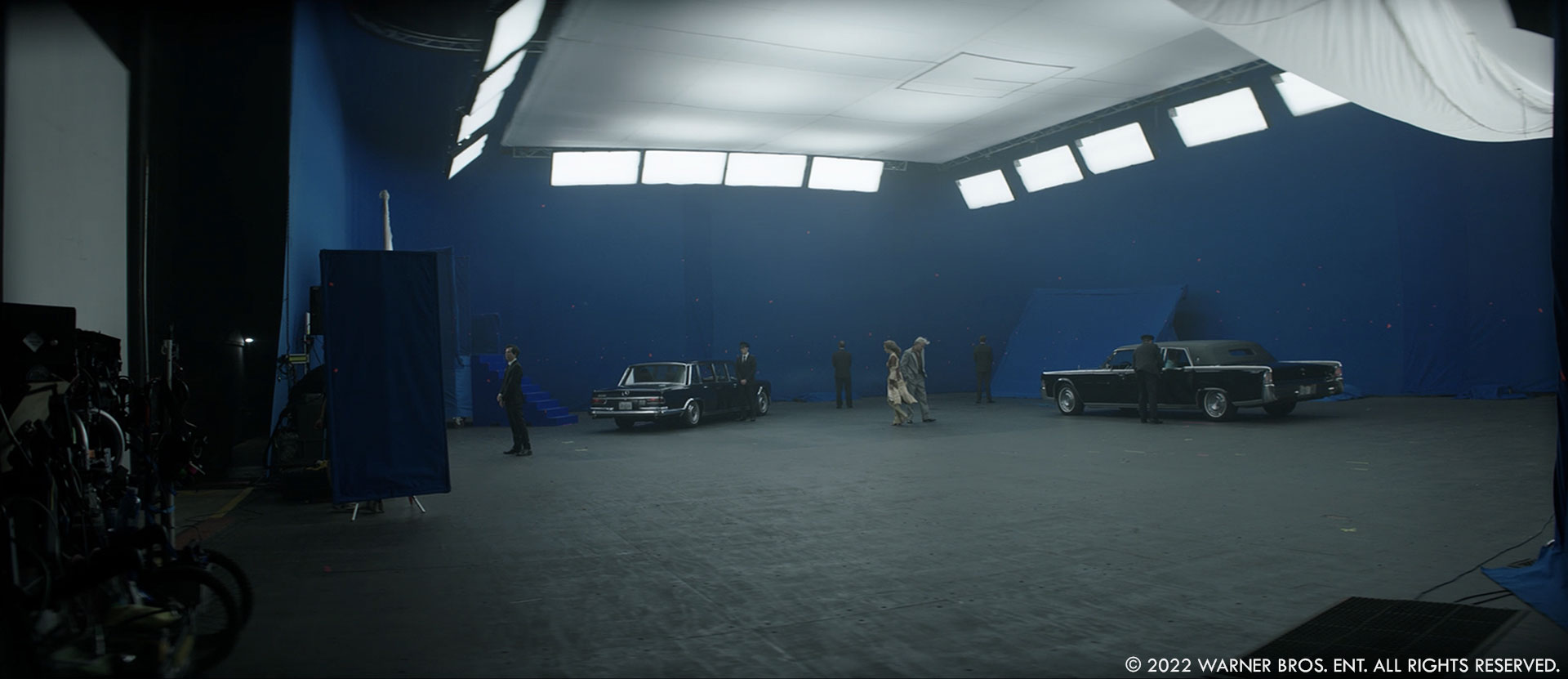
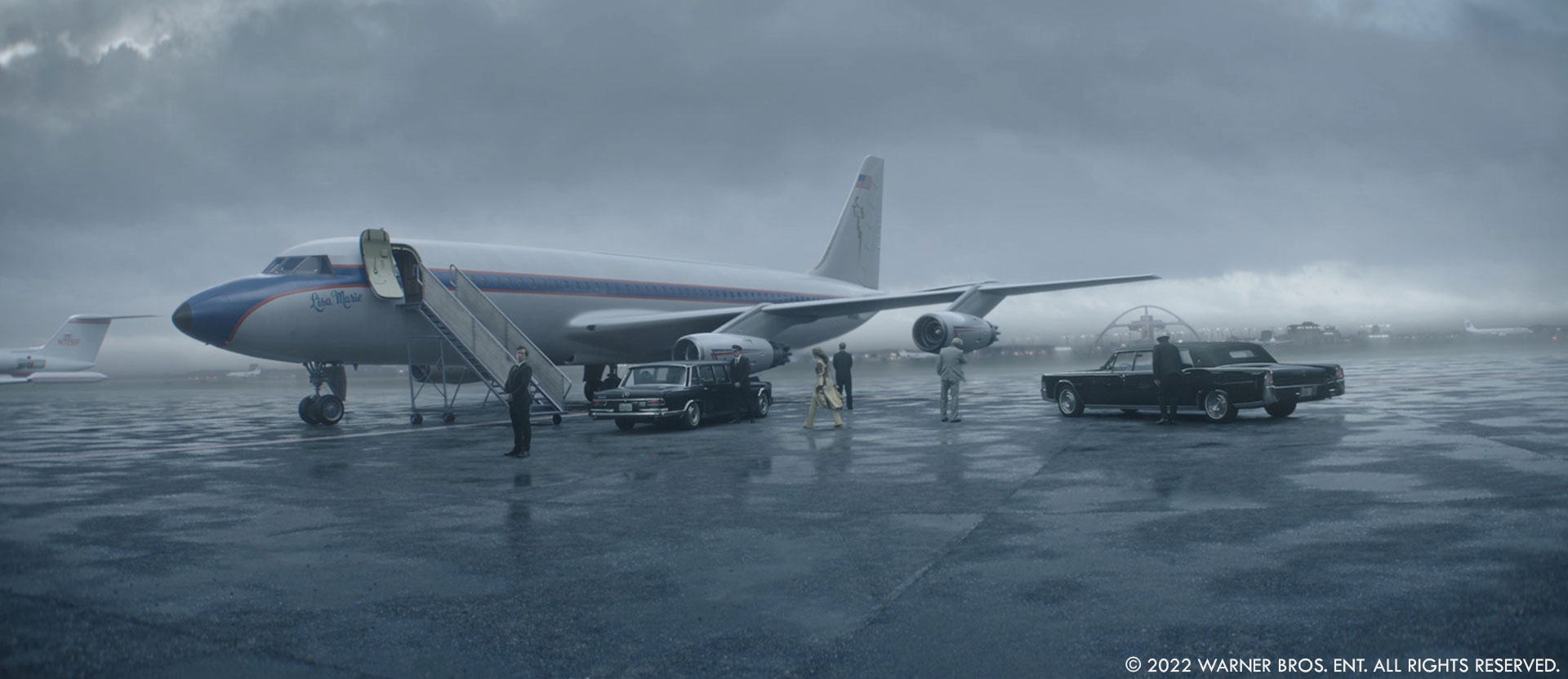
How long have you worked on this show?
3 years!
What’s the VFX shots count?
We produced 2400 finished shots of which 1800 are in the final cut.
What is your next project?
I’m currently spending time at home with my family.
A big thanks for your time.
// Elvis – The first 10 minutes
WANT TO KNOW MORE?
Double Barrel VFX: Dedicated page about Elvis on Double Barrel VFX website.
Fin Design + Effects: Dedicated page about Elvis on Fin Design + Effects website.
Method Studios: Dedicated page about Elvis on Method Studios website.
MPC: Dedicated page about Elvis on MPC website.
Rising Sun Pictures: Dedicated page about Elvis on Rising Sun Pictures website.
© Vincent Frei – The Art of VFX – 2022






